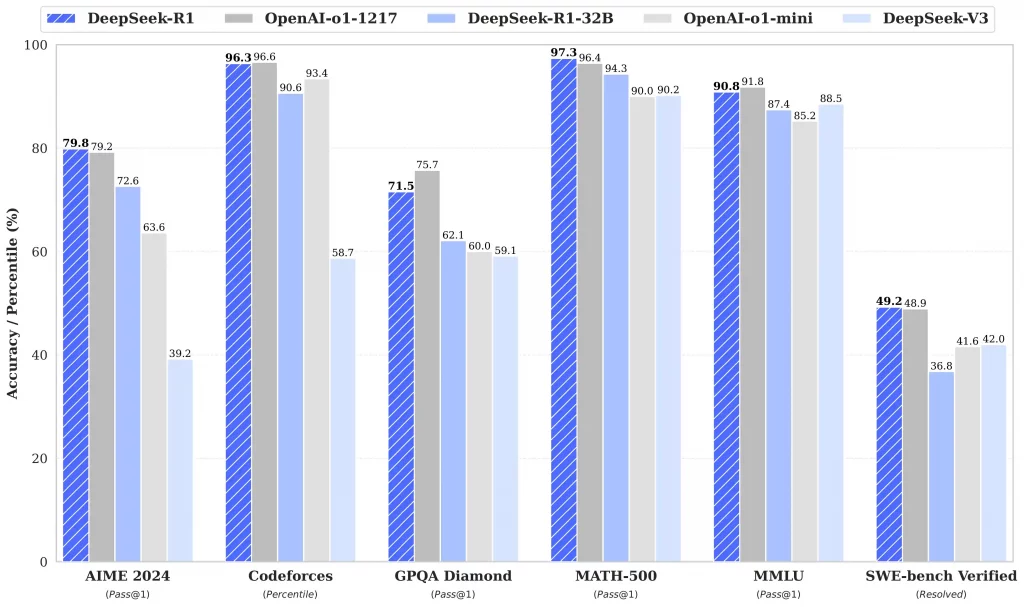Artificial intelligence is advancing rapidly, with DeepSeek-R1 emerging as the latest model making waves in the industry. But how does it compare to OpenAI’s offerings?
In this post, we’ll dive into what DeepSeek-R1 has to offer – its features, performance in crucial benchmarks, and real-world applications – so you can determine if it suits your requirements.
What Is DeepSeek-R1?
DeepSeek-R1 is a cutting-edge “reasoning-first” AI model that seeks to go beyond conventional language models by focusing on the process it uses to reach conclusions.
Developed using large-scale reinforcement learning techniques, DeepSeek-R1 and its precursor, DeepSeek-R1-Zero, prioritize transparency, mathematical proficiency, and logical coherence.
It recently surpassed OpenAI’s ChatGPT in the Apple App Store, claiming the top spot for free apps in the U.S. as of January 2025.
Key points to remember:
- Open-Source Release: DeepSeek provides the main model (DeepSeek-R1) along with six distilled variants (ranging from 1.5B to 70B parameters) under the MIT license. This open approach has garnered significant interest among developers and researchers.
- Reinforcement Learning Focus: DeepSeek-R1’s reliance on RL allows it to “discover” reasoning patterns more naturally.
- Hybrid Training: Following initial RL exploration, supervised fine-tuning data was added to address readability and language-mixing issues, enhancing overall clarity.
From R1-Zero to R1: How DeepSeek Evolved
DeepSeek-R1-Zero was the initial version, trained via large-scale reinforcement learning without supervised fine-tuning. This pure-RL approach helped the model discover powerful reasoning patterns like self-verification and reflection. However, it also introduced problems such as:
- Poor Readability: Outputs were often difficult to comprehend.
- Language Mixing: Responses could blend multiple languages, reducing clarity.
- Endless Loops: Without SFT safeguards, the model occasionally fell into repetitive answers.
DeepSeek-R1 addresses these issues by incorporating a supervised pre-training step before RL. The outcome – more coherent outputs and robust reasoning, comparable to OpenAI on math, coding, and logic benchmarks.
Suggested: What is Generative AI?
Core Features & Architecture

- Mixture of Experts (MoE) Architecture: DeepSeek-R1 utilizes a large MoE setup – 671B total parameters with 37B activated during inference. This design ensures only the relevant parts of the model are used for a given query, reducing costs and speeding up processing.
- Built-In Explainability: Unlike many “black box” AIs, DeepSeek-R1 includes step-by-step reasoning in its output. Users can trace how an answer was formed – crucial for use cases like scientific research, healthcare, or financial audits.
- Multi-Agent Learning: DeepSeek-R1 supports multi-agent interactions, enabling it to handle simulations, collaborative problem-solving, and tasks requiring multiple decision-making components.
- Cost-Effectiveness: DeepSeek mentions a relatively low development cost (around $6 million) and emphasizes lower operational expenses, thanks to the MoE approach and efficient RL training.
- Ease of Integration: For developers, DeepSeek-R1 is compatible with popular frameworks like TensorFlow and PyTorch, alongside ready-to-use modules for rapid deployment.
How Does DeepSeek-R1 Compare to OpenAI’s Models?

DeepSeek-R1 directly competes with OpenAI’s “o1” series (e.g., GPT-based models) across math, coding, and reasoning tasks. Here’s a snapshot of how they perform on critical benchmarks, based on reported data:
| Benchmark | DeepSeek-R1 | OpenAI o1-1217 | Notes |
|---|---|---|---|
| AIME 2024 | 79.8% | 79.2% | Advanced math competition |
| MATH-500 | 97.3% | 96.4% | High-school math problems |
| Codeforces | 96.3% | 96.6% | Coding competition percentile |
| GPQA Diamond | 71.5% | 75.7% | Factual Q&A tasks |
- Where DeepSeek Shines: Mathematical reasoning and code generation, thanks to RL-driven CoT.
- Where OpenAI Has an Edge: General knowledge Q&A, plus slightly better coding scores on some sub-benchmarks.
Distilled Models: Qwen and Llama
DeepSeek doesn’t stop at the main R1 model. They distill the reasoning abilities into smaller, dense models based on both Qwen (1.5B to 32B) and Llama (8B & 70B). For example:
- DeepSeek-R1-Distill-Qwen-7B: Achieves over 92% on MATH-500, outperforming many similarly sized models.
- DeepSeek-R1-Distill-Llama-70B: Hits 94.5% on MATH-500 and 57.5% on LiveCodeBench – close to some OpenAI-coded models.
This modular approach allows smaller organizations to leverage high-level reasoning without requiring massive GPU clusters.
Practical Use Cases
- Advanced Math & Research
- Universities and R&D labs can utilize the step-by-step problem-solving abilities for complex proofs or engineering tasks.
- Coding & Debugging
- Automate code translation (e.g., from C# in Unity to C++ in Unreal).
- Assist with debugging by identifying logical errors and providing optimized solutions.
- Explainable AI in Regulated Industries
- Finance, healthcare, and government sectors demand transparency. DeepSeek-R1’s chain-of-thought clarifies how it reaches each conclusion.
- Multi-Agent Systems
- Coordinate robotics, autonomous vehicles, or simulation tasks where multiple AI agents must interact seamlessly.
- Scalable Deployments & Edge Scenarios
- Distilled models suit resource-limited environments.
- Large MoE versions can handle enterprise-level volumes and long context queries.
Also Read: Janus-Pro-7B AI Image Generator – By DeepSeek
Access & Pricing
- Website & Chat: chat.deepseek.com (includes “DeepThink” mode for reasoning).
- API: platform.deepseek.com, OpenAI-compatible format.
- Pricing Model:
- Free Chat: Daily cap of ~50 messages.
- Paid API: Billed per 1M tokens, with varying rates for “deepseek-chat” and “deepseek-reasoner.”
- Context Caching: Reduces token usage and total cost for repeated queries.
Future Prospects
- Ongoing Updates: DeepSeek plans to enhance multi-agent coordination, reduce latency, and offer more industry-specific modules.
- Strategic Partnerships: Collaborations with major cloud providers (AWS, Microsoft, Google Cloud) are being explored to expand deployment options.
- Growing Global Impact: With a brief stint at the top of the U.S. App Store for free AI apps, DeepSeek is establishing itself as a serious contender that could reshape the adoption of open-source AI worldwide.
Final Thoughts
DeepSeek-R1 represents a significant advancement in open-source AI reasoning, with performance that rivals (and sometimes exceeds) OpenAI’s models in math and coding tasks. Its reinforcement-learning-first approach, coupled with supervised refinements, produces rich, traceable chain-of-thought outputs that appeal to regulated and research-oriented fields. Additionally, distilled versions make advanced reasoning accessible to smaller teams.
If you’re interested in mastering these technologies and unlocking their full potential, Great Learning’s AI and ML course offers a comprehensive curriculum that merges theoretical knowledge with hands-on experience.
Suggested:



